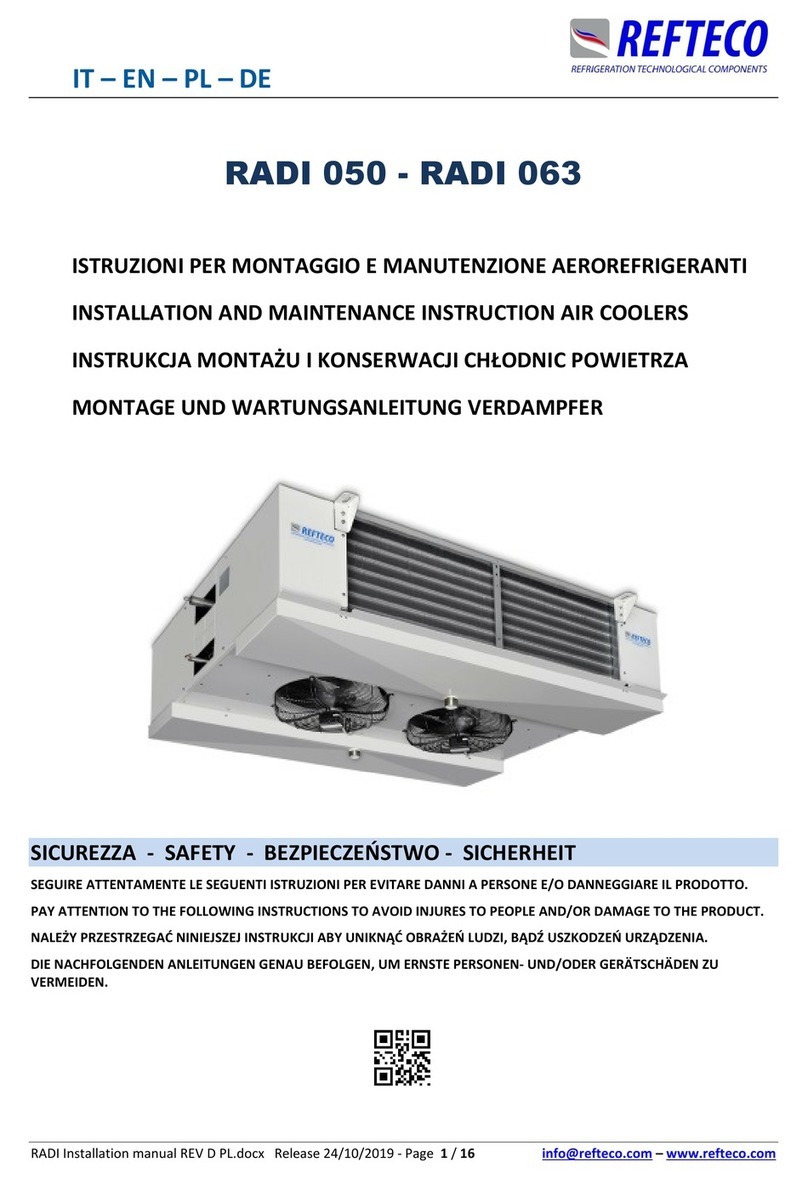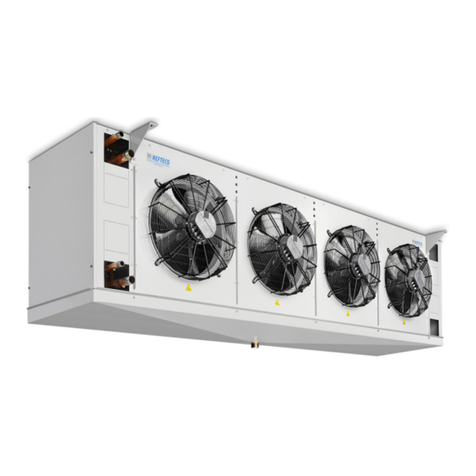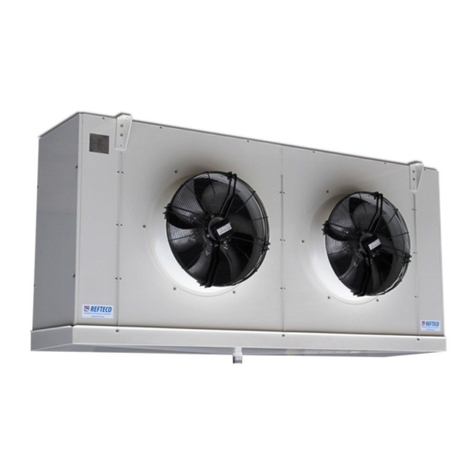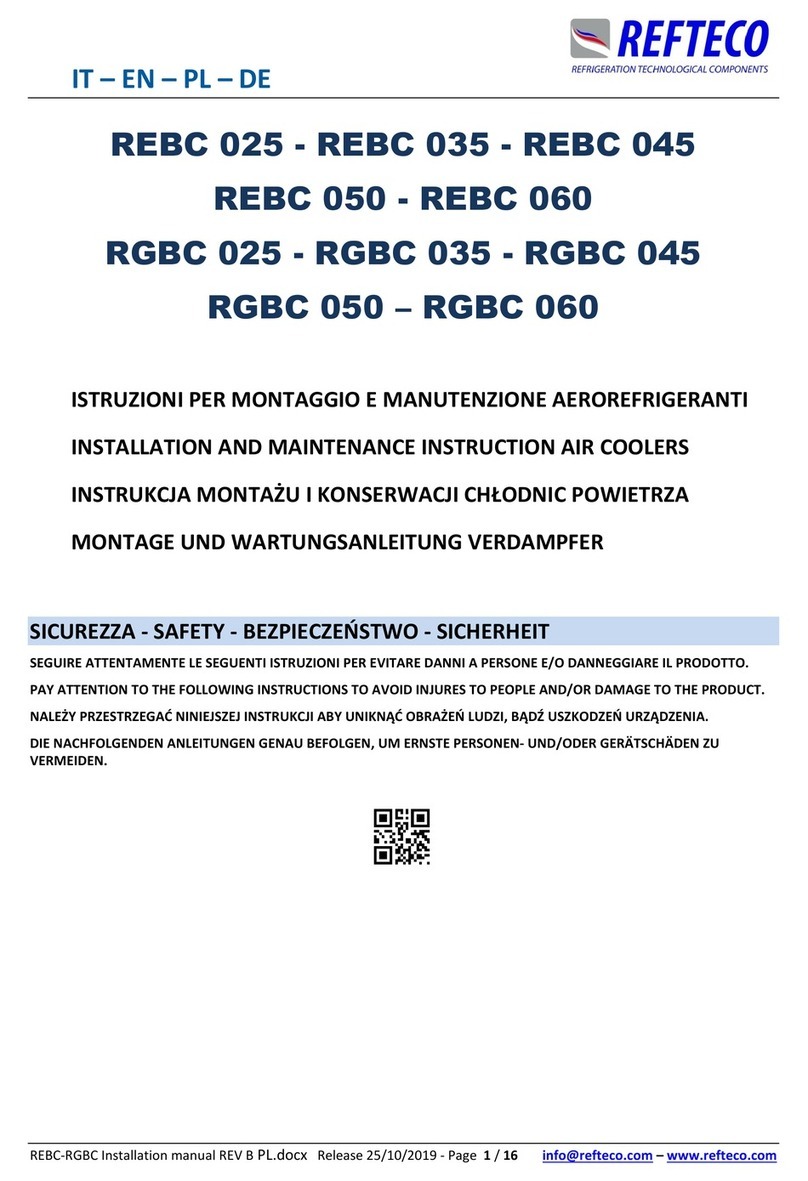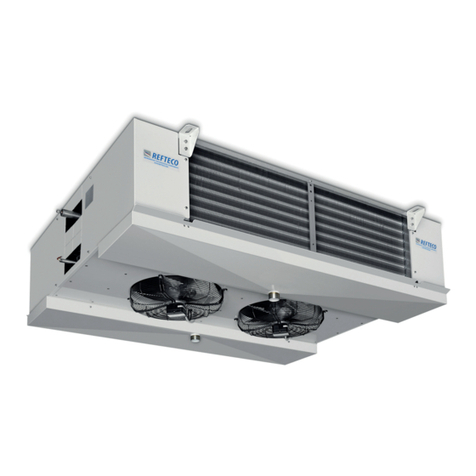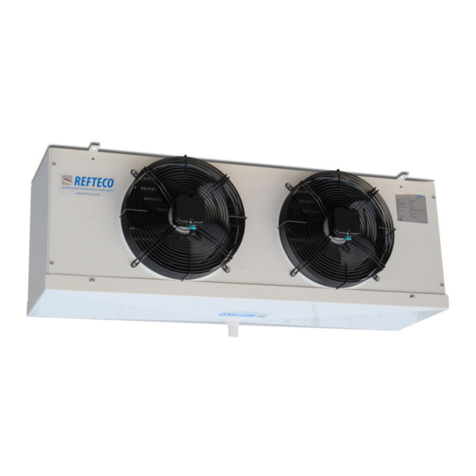
IT – EN – PL – DE
REBF, RGBF, RABF Installation manual REV D PL.docx Release 24/1 /2 19 - Page 10 / 18 info@refteco.com –
www.refteco.com
Ważne:
• Średnice przyłączanych rur muszą odpowiadać średnicom przyłączy wlotowych i wylotowych wężownicy.
• Zawory odcinające (ON-OFF) muszą być zainstalowane blisko urządzenia aby umożliwić normalną konserwację.
• Należy zastosować połączenia tłumiące wibracje.
• Wszystkie połączenia gwintowane powinny zostać uszczelnione taśmą teflonową.
Hydraulische Anschlüsse der Brine-Einheit
Die Anlage komplett entlüften und überprüfen, dass keine Druckstöße vorhanden sind.
Die Funktionstüchtigkeit des Speisemagnetventils oder des Mischventils überprüfen. Wichtig:
• Bei der Dimensionierung der Leitungen muss der Durchmesser der Anschlüsse IN und OUT des Pakets berücksichtigt
werden.
• Die Sperrventile (ON-OFF) in der Nähe der Einheit installieren, damit die Wartungsarbeiten regular durchgeführt werden
können.
• Schwingungsgedämpfte Anschlüsse verwenden.
• Alle Gewinde mit TEFLON überziehen, um die Dichtigkeit zu gewährleisten.
Tubature per lo scarico della condensa (fig.5)
La linea di scarico di ogni unità va collegata al giunto gas femmina posizionato al centro della vasca di sgocciolamento e va
collegata tramite tubi a un sifone indipendente per evitare che l’aria calda passi attraverso le linee di scarico. L’inclinazione
minima non deve essere inferiore a 6 °. Le connessioni della vaschetta di scarico, le linee di scarico e i sifoni che si trovano a
temperature estremamente basse devono essere tracciati con cavi elettroscaldanti e coibentati in modo da prevenirne il
congelamento. Mantenere gli elementi riscaldanti costantemente sempre sotto tensione. Supportare tutti i tubi in modo
adeguato indipendentemente dall’unità a cui sono collegati in modo da evitare di esercitare peso sulla connessione della
vaschetta. Durante lo sbrinamento, riscaldare il tubo di scarico utilizzando un riscaldatore elettrico installato all’interno del
tubo stesso.
Condensation discharge piping (fig.5)
The drain line for each unit should be connected to the female gas joint, located in the center of the drip tray and must be
piped to an independent trap to prevent the migration of warm air through the drain lines. The minimum slope must not be
less than 6 °. Drain pan connections and any drain lines and traps that are in freezing temperatures must be heat traced and
insulated to prevent freezing. Heating elements should be continuously energized. All piping should be adequately
supported, independently of the unit so no weight is exerted on the pan connection. During the defrosting time, the
discharge pipe should be heated by an electrical heater placed inside the pipe.
Instalacja odprowadzenia skroplin (rys. 5)
Instalację odprowadzenia skroplin każdej jednostki należy podłączyć przez żeński króciec przyłączeniowy umiejscowiony w
centralnym punkcie tacy ociekowej. Każde urządzenie powinno posiadać niezależne zasyfonowanie aby zapobiec migracji
ciepłego powietrza przez przewody spustowe. Minimalne nachylenie nie może być mniejsze niż 6 %. Przyłącze tacy
ociekowej oraz wszelkie przewodu spustowe i syfony w przypadku temperatur ujemnych należy wyposażyć w elementy
grzejne i zaizolować zabezpieczając przed zamarzaniem. Element grzejny powinien być wyposażony w stałe zasilanie.
Wszystkie rurociągi powinny być odpowiednio podparte, niezależnie od urządzenia, tak aby żadne obciążenia nie były
przenoszone na króciec tacy ociekowej. Podczas cyklu odszraniania rura spustowa skroplin powinna być ogrzewana grzałką
elektryczną zamontowaną wewnątrz rury.
Kondensatablassleitungen (fig.5)
Die Ablassleitung jeder Einheit ist an den Bsp-Anschluss mit Innengewinde in der Mitte des Tropfbeckens anzuschließen. Der
Anschluss muss mittels Rohren an einen unabhängigen Siphon erfolgen, damit die heiße Luft nicht durch die Ablassleitungen
strömt. Die Mindestneigung darf nicht unter 6 ° liegen. Anschlüsse des Ablassbeckens, Ablassleitungen und Siphone mit
extrem niedriger Temperatur müssen mit elektrischen Heizkabeln versehen und isoliert werden, damit sie nicht einfrieren
können. Die Heizelemente immer unter Spannung halten. Alle Rohre korrekt unabhängig von der Einheit, an die sie
angeschlossen sind, abstützen, damit kein Gewicht auf dem Beckenanschluss lastet. Beim Enteisen das Ablassrohr mit einem
im Rohr selbst installierten elektrischen Erhitzer Erwärmen.
